July 2, 2025
0
min read
7 Best Jira Service Management Alternatives by Use Case

On this page
Try Risotto for free for 30 days. Commit only when you see the value.
7 Best Jira Service Management Alternatives by Use Case
Jira Service Management supports a vast range of use cases, from AI-powered ITSM and automated tier-1 ticket resolution to essential operational processes, including request management, incident and problem management, change management, and beyond.
Given the wide range of reasons teams seek Jira Service Management alternatives, we've organized our analysis into two main parts:
Part 1: AI-Powered ITSM & Tier-1 Ticket Resolution
While Jira Service Management offers AI automation features designed to automate repetitive tier-1 tickets — software access requests, password resets, and basic troubleshooting — IT teams face significant challenges:
- Complex setup process: Configuring AI workflows often requires weeks or months of dedicated effort, and there’s a steep learning curve.
- Ongoing maintenance burden: Keeping workflows running smoothly demands constant attention, with the risk of breaking existing processes.
- Limited effectiveness: From our experience, JSM’s AI automation fails to meaningfully reduce tier-1 ticket volume — even after the setup.
We'll start by exploring how Risotto (our product) addresses these limitations to automate 20–60% of tier-1 tickets. For example, Hazel Health switched from Jira Assist & Atlassian Virtual Agent to Risotto, increasing deflection rates from 3–5% to over 20%.
Part 2: JSM Alternatives for Broader Use Cases
Beyond AI for ITSM, we'll evaluate six other Jira Service Management alternatives — Zendesk, Freshservice, Servicenow, PagerDuty, Ivanti, and BMC — that more closely match JSM's wider range of capabilities, such as:
- Request management
- Incident management
- Problem management
- Change management
- Asset and configuration management
- Knowledge management
- SLA Management
Many of the alternatives we'll cover serve not only IT, but also development teams and other departments.
In short, whether you're looking to solve specific AI automation challenges or need broader-featured, all-in-one JSM replacements, this article will help you find the right solution for your business needs.
Best Jira Service Management Alternatives
1. Risotto
AI-Powered ITSM & Tier-1 Ticket Resolution

Risotto is an AI-powered IT support platform designed specifically to automate tier-1 tickets and streamline internal employee support in Slack.
In this section, we’ll discuss:
- Brief Overview of Risotto’s Key Strengths: Automating common IT actions (including software access requests and password resets) and multi-step troubleshooting for knowledge-based questions.
- Hazel Health Case Study: Switching from Jira Assist & Atlassian Virtual Agent to Risotto and improving deflection rates from 3–5% to over 20%.
- Why Choose Risotto Over Jira Service Management?
- Software Access Automation: Hours vs. Weeks
- Password Resets: Immediate Value vs. Complex Setup
- Higher Quality Responses for Knowledge-Based Questions
- Expanding Risotto beyond IT to other departments like HR, Sales, Legal, etc.
Let’s dive in.
Brief Overview of Risotto’s Key Strengths
Unlike Jira Service Management and other traditional ITSM platforms that require extensive configuration and maintenance, Risotto works out of the box and excels in 2 key areas:
1. Automating common IT actions: This includes password resets and software access automation (time-based access, approval-based access, and self-service access).

2. Multi-step troubleshooting: For knowledge-based tickets (e.g., “My Wi-Fi isn’t working”), Risotto uses cutting-edge natural language understanding to identify the core issue, ask relevant clarifying triage questions, access knowledge from multiple sources, and guide employees through step-by-step resolutions:
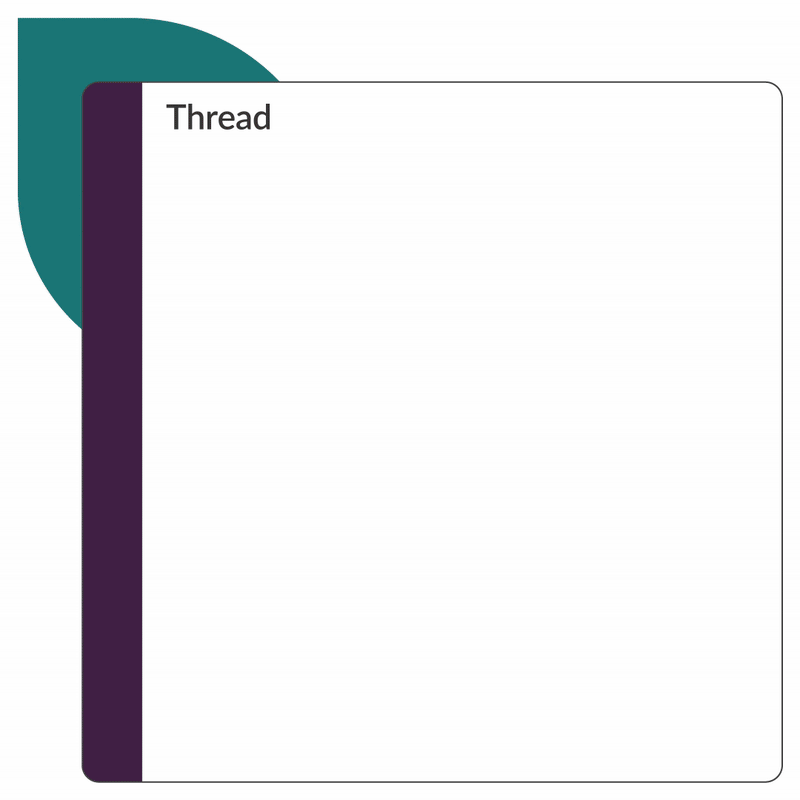
Most Risotto customers use Risotto to augment their existing Jira setup through seamless bi-directional sync, allowing them to keep Jira as their system of record while dramatically reducing manual ticket resolution work through Risotto's AI automation.

Risotto can also serve as your primary ticketing system, providing both conversational AI capabilities and complete ticketing functionality in one unified platform. This is particularly valuable when expanding AI-powered support beyond IT to departments like HR, Sales, Legal, etc., who find tools like Jira overly complex and prefer Risotto's built-in ticketing system.
Hazel Health Switched from Jira Assist & Atlassian Virtual Agent to Risotto — Deflection Rose from 3–5% to 20%+

The challenge: Hazel Health, a telehealth services company supporting over 5 million students, was struggling to manage high volumes of IT tickets across departments, products, and time zones, and wanted to maintain quality support without expanding the IT team.
Prior to Risotto: Their IT team had been using Jira Assist combined with Atlassian Virtual Agent. However, even after investing considerable time tweaking keyword triggers and maintaining workflows, deflection rates remained disappointingly low at just 3–5%.
After switching to Risotto, Peter Hadjisavas, Head of IT at Hazel Health, noted:
“We started seeing deflection rates jump from over 3–5% to over 20%, which is huge”.
“Ease of deployment was huge. We didn’t need a consultant or months of configuration. Risotto just worked.”
Hazel Health needed more than a bot that simply linked to knowledge articles. They required an intelligent AI chatbot that could understand the intent behind employee questions and actively guide them through detailed solutions, and that's precisely what Risotto excels at:
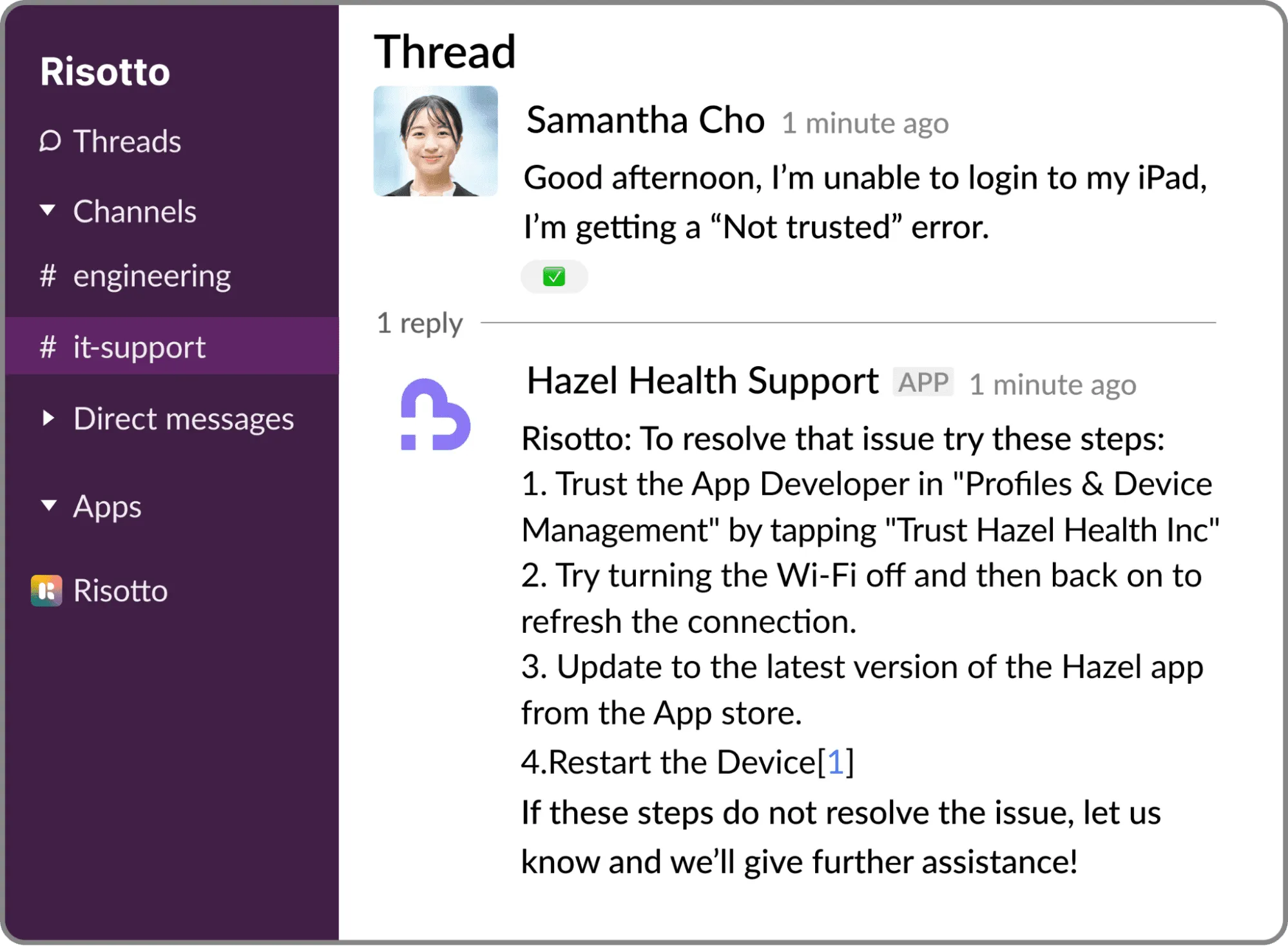
Another key Risotto advantage is that instead of only referencing knowledge base articles to answer employee questions, Risotto automatically learns from past resolved tickets and Slack conversations. This reduces the time you spend on knowledge creation and maintenance.
As Peter from Hazel Health noted:
“Risotto started answering complex product questions even I didn’t know off the top of my head… It was pulling insights from our own past Slack conversations, surfacing knowledge that would have otherwise been buried.”
“The more we use Risotto, the smarter it gets, that’s what makes it different from every other tool we’ve tried.”
For more information, read the full Hazel Health case study.
We also invite you to explore additional customer success stories:
- Fundrise Case: Automated nearly 60% of IT support tasks.
- Superhuman: Automated nearly 20% of IT support requests.
- Retool: Cut SLA ticket resolution from 2 days to under 1 day on average.
- Vidyard: Automated nearly 56% of IT requests.
Why Choose Risotto Over Jira Service Management?
🚫 The fundamental challenge with Jira Service Management is its complexity and the time burden it places on IT teams. Setting up AI automation workflows in JSM requires weeks or months of dedicated configuration work, and that's just the beginning. Anytime you need to make changes — whether updating workflows, modifying permissions, or scaling for organizational growth — you're looking at a significant time investment and the constant risk of breaking existing processes.
❇️ The Risotto difference: get set up in hours. Risotto takes a fundamentally different approach. Instead of requiring you to configure everything from scratch, we've pre-built the core IT support workflows that teams need. What takes weeks or months to set up in JSM can be deployed in just a few hours with Risotto.
To re-emphasize, as Peter from Hazel Health noted after switching from Jira Assist & Atlassian Virtual Agent to Risotto:
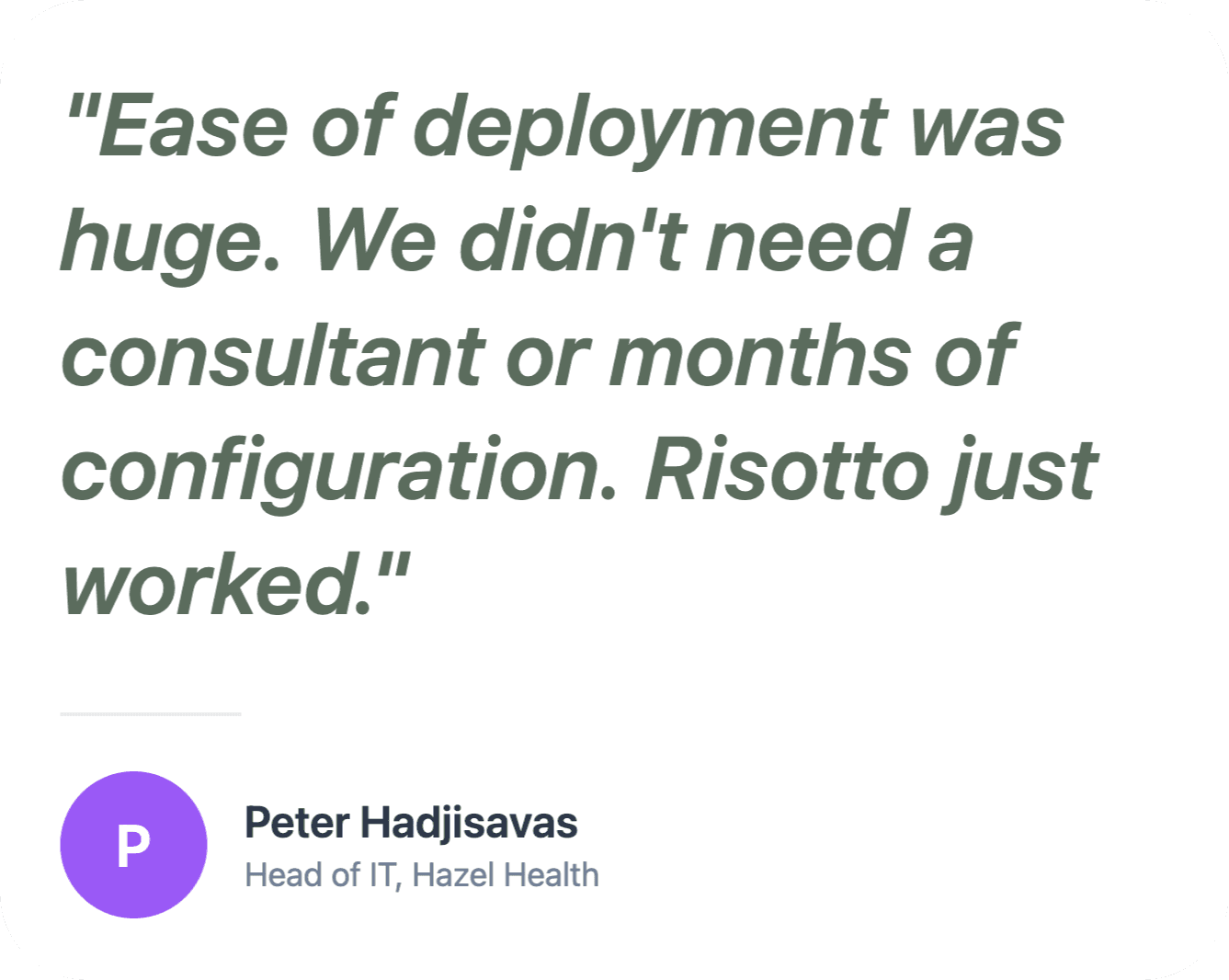
This isn't just about initial setup — it's about ongoing management. When you need to update workflows or add new capabilities, Risotto's self-service dashboard lets you make changes confidently without the fear of breaking existing processes. Plus, we provide white-glove onboarding to ensure you get maximum value from day one.
Customer experience speaks volumes. As Collin Clifford, Compliance and Legal Program Manager at Superhuman, noted in our case study:
"Risotto had the most thorough onboarding experience I've ever been a part of. Alex was great - he met with us weekly and made it very easy to quickly get up and running.”
"Risotto has been one of the best products we've implemented in years, and that's coming from people here who set a very high bar for new tools.”
Next, we'll dive into three specific areas where this out-of-the-box approach shines:
- Software Access Automation: Hours vs. Weeks
- Password Resets: Immediate Value vs. Complex Setup
- Higher Quality Responses for Knowledge-Based Questions
Software Access Automation: Hours vs. Weeks
Software access requests represent roughly 40% of IT tickets in most organizations, making them the ultimate test case for any AI IT help desk platform. The difference between Risotto and Jira Service Management becomes starkly apparent here.
🚫 Automating software access in JSM means building everything from scratch. You'll need to:
- Configure custom webhooks and API integrations with identity providers like Okta.
- Set up third-party automation tools like Zapier or Workato to bridge the gaps.
This would take IT teams weeks or months to implement properly, and requires complex ongoing maintenance as your software stack evolves.
❇️ Risotto comes with software access automation built in. Our native Okta integration lets you import your existing applications and permissions in minutes, not weeks:
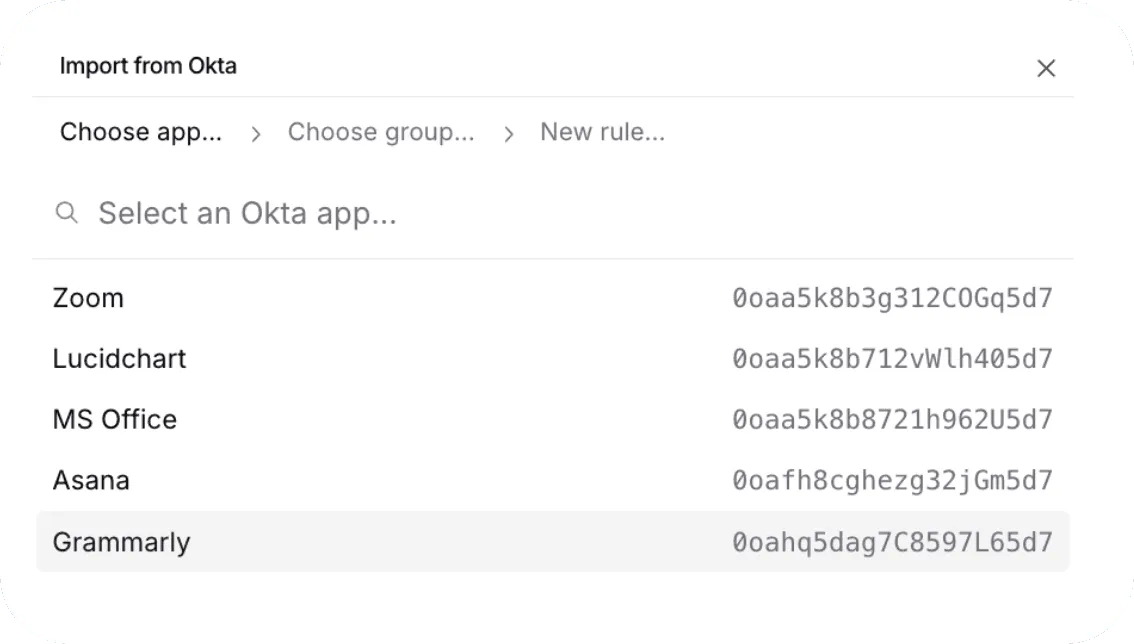
Here's the centralized dashboard view showing all your applications:
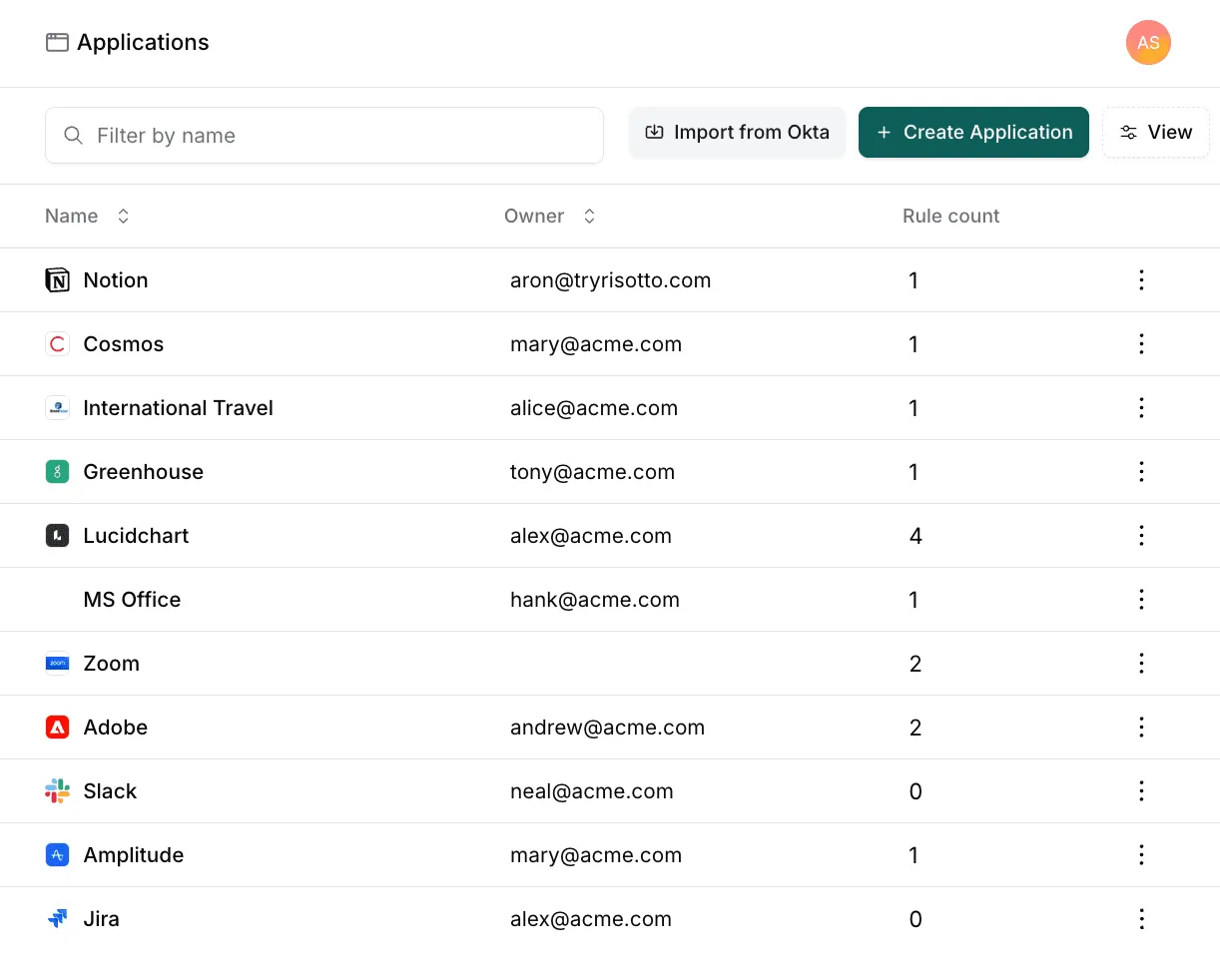
For each application in your dashboard, Risotto provides powerful configuration tools:
- RBAC Rule Builder using intuitive Boolean logic. No complex setup required — just point, click, and set your rules.
- Approval Workflow Builder. Choose from sequential approvals, broadcast approvals, "all-of" logic (all approvers must approve), "any-of" logic (single approver sufficient), and more.
Once you configure these settings through Risotto's intuitive interface, our platform automatically handles three types of access workflows: time-based, approval-based, and self-service access.
- Time-Based Access: Employee asks, “Can I get a license for Adobe so that I can edit PDFs?” → Risotto asks, “How long do you need access for?” → Employee replies “Just a few weeks” → Risotto grants access for 3 weeks and automatically revokes it once the time expires, without manual intervention from a human agent → Risotto logs each step for compliance audit purposes.

- Approval-Based Access: Employee requests Amplitude access → Risotto asks, "What do you need Amplitude access for?" → Employee replies, "I need to create reports for sales" → Risotto automatically creates a ticket (seamless bi-directional sync with Jira), logs the business justification, and sends an approval request to the appropriate person in Slack → Upon approval, Risotto provisions the access.
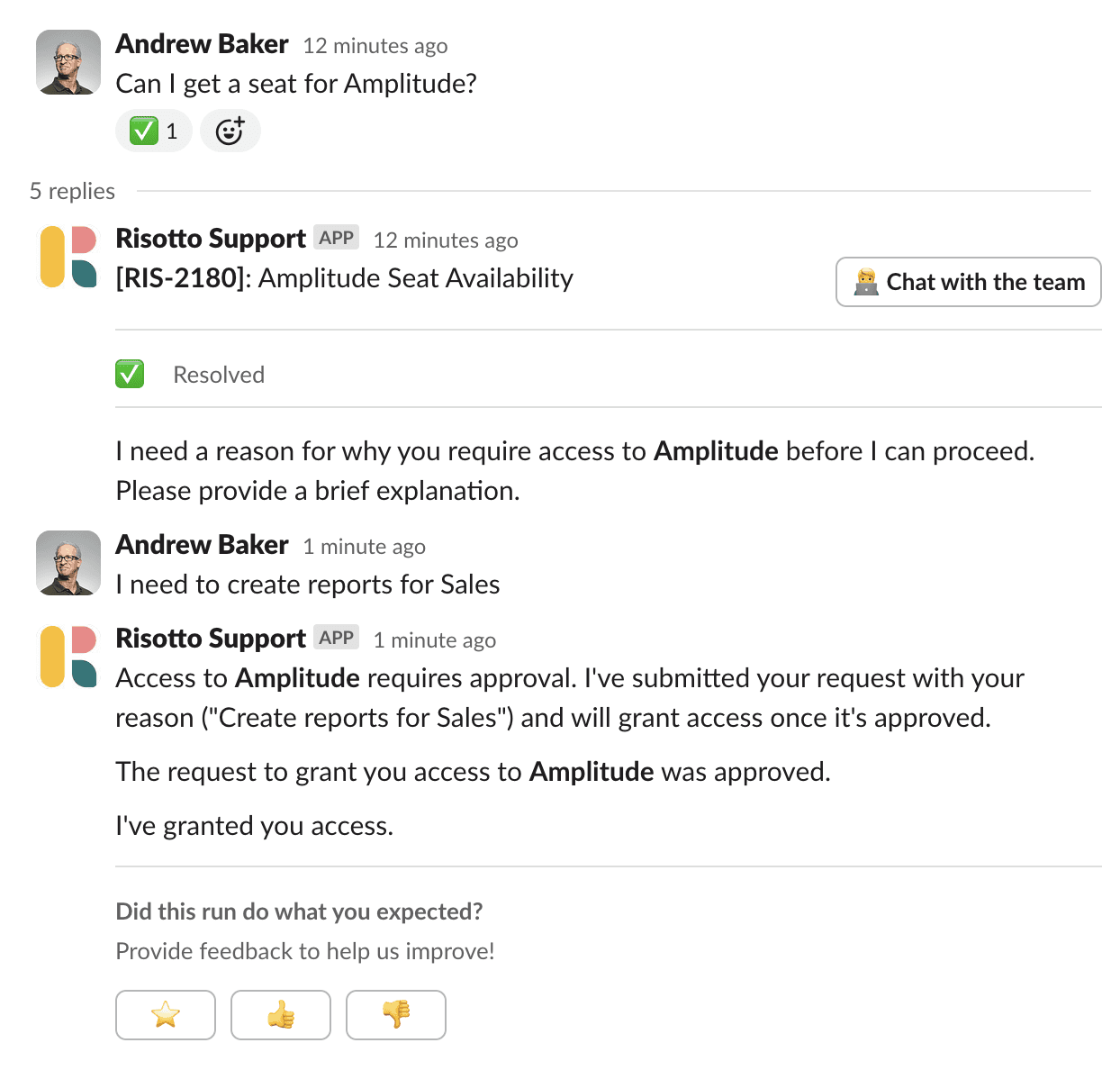
- Self-Service Access: Employee asks for access to Lucidchart → Risotto asks the employee what type of access they need → Risotto automatically grants “Read Only” access for low-risk applications, based on your pre-configured settings.
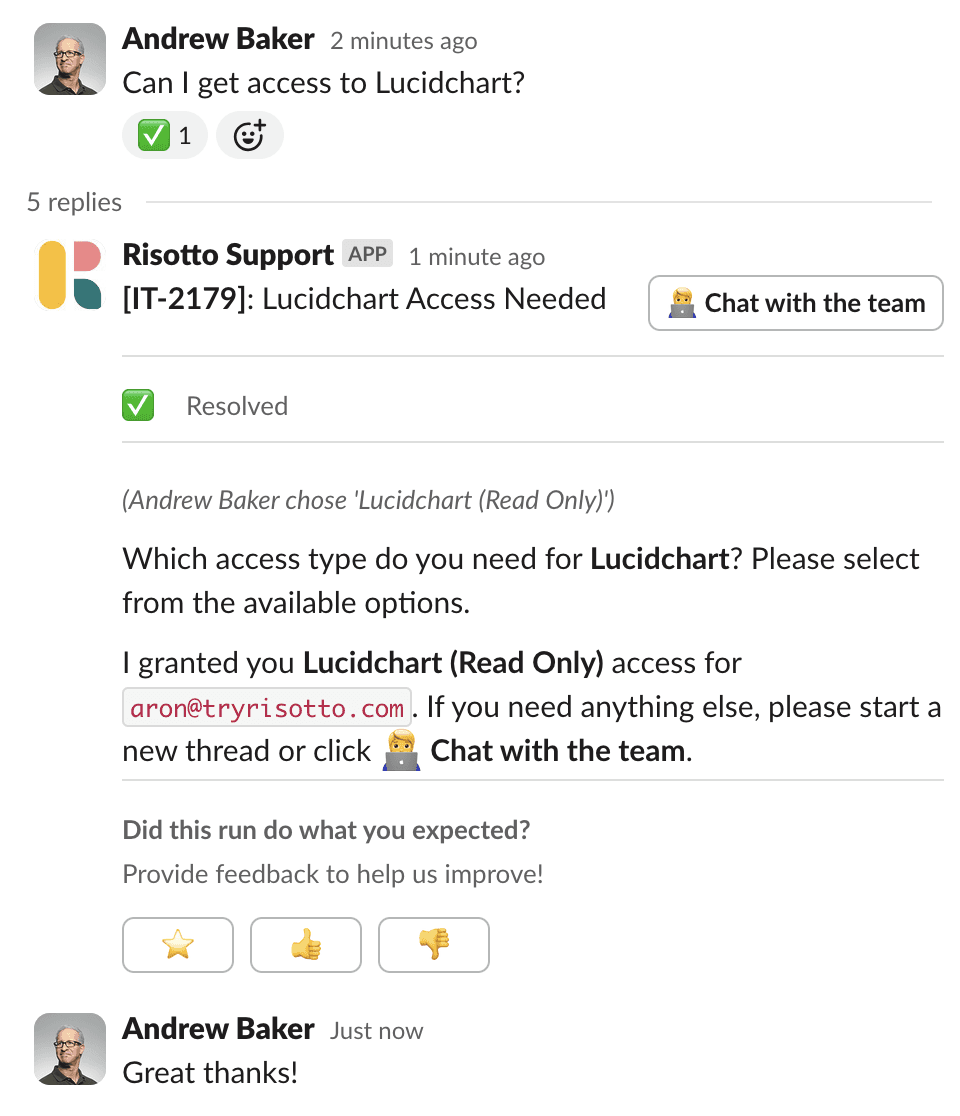
Here’s what our customers are saying:
Fundrise Case Study
“With our old chatbot, every new application required a cumbersome onboarding process through the vendor. Now, adding an application to Risotto takes just a few minutes.”
“Risotto intelligently understands the intent behind the request. It confirms existing permissions, coordinates necessary approvals proactively, and automatically provisions access upon approval. This automation significantly speeds up provisioning and improves user satisfaction.”
Superhuman Case Study
"Automated software access saves us so much time. Within minutes people get the access they need with everything tracked, approved, and no additional overhead needed.”
“For sensitive tools and resources Risotto's automated time-based access has been a game-changer.”
Password Resets: Immediate Value vs. Complex Setup
🚫 Jira's Approach
To automate a simple password reset flow, you must:
- Manually configure dozens of keyword triggers ("reset," "password," "locked out," "can't login," etc.).
- Build complex if/then workflow logic for each scenario.
- Cross your fingers that employees use your exact keywords — otherwise, the automation fails completely.
❇️ Risotto's Approach
Through powerful NLP (Natural Language Processing), Risotto’s AI understands intent, not just keywords. Employees can say "I'm locked out," "forgot my login," "can't get into my account," or any natural variation — Risotto automatically recognizes it's a password issue and handles it seamlessly.
This fundamental difference extends to every aspect of AI support. Jira's keyword-based matching creates brittle workflows that break when employees ask questions in unexpected ways. Risotto's conversational AI adapts to how people naturally communicate.
Higher Quality Responses for Knowledge-Based Questions
🚫 Jira Service Management is designed around single-response interactions, often providing unhelpful answers or redirecting employees to knowledge base articles.
❇️ Risotto's Conversational Approach: Instead of static responses, Risotto engages like an experienced IT team member would. It asks intelligent triage questions, adapts to unexpected responses, analyzes screenshots, and combines information from multiple sources (not just knowledge articles but also recent Slack conversations and past tickets).
Next, we’ll share 4 examples demonstrating Risotto’s answer quality:
- Example #1: Intelligent Triage
- Example #2: Adapting to Context Changes
- Example #3: Screenshot Recognition
- Example #4: Combining Multiple Knowledge Sources
Example #1: Intelligent Triage
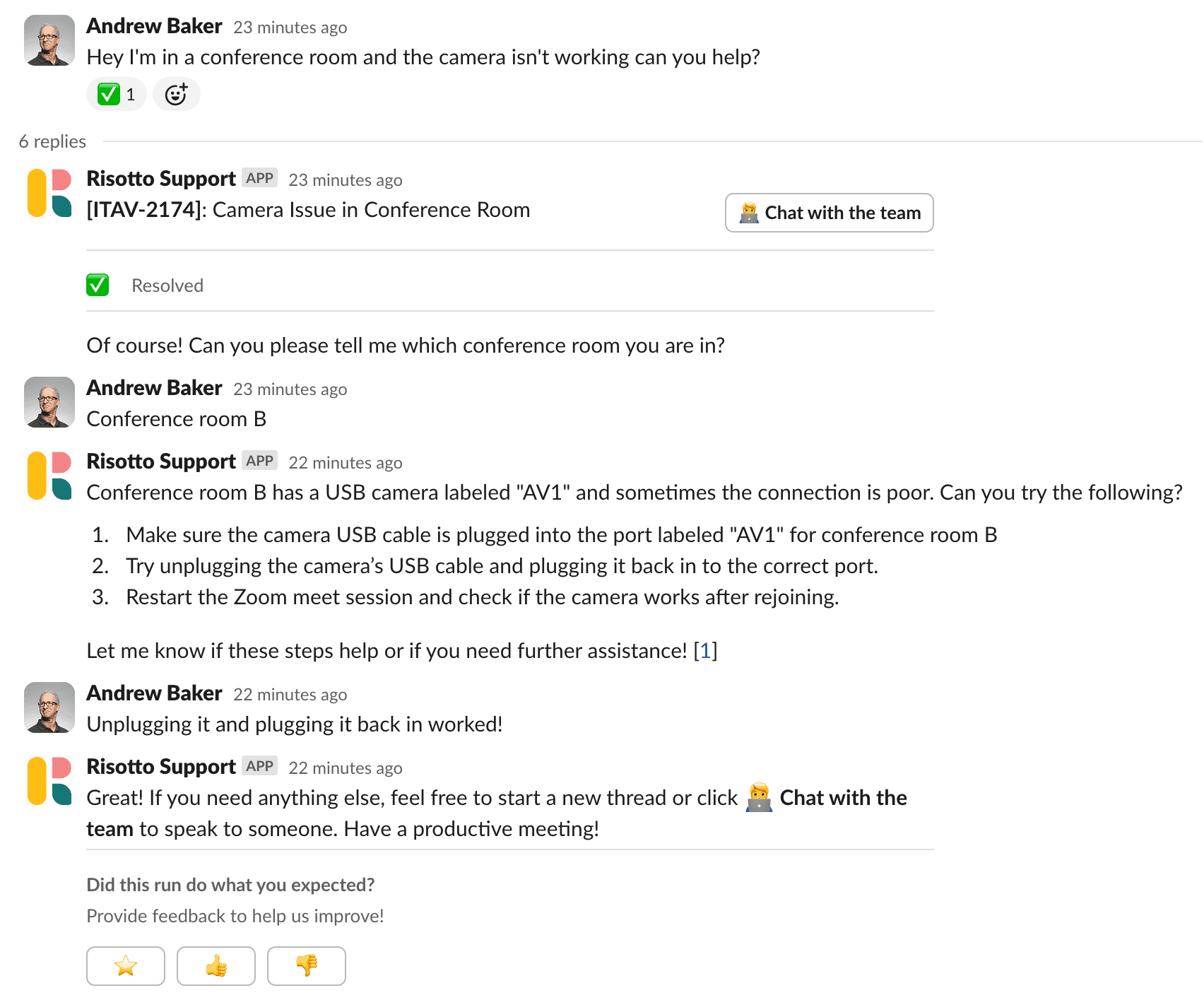
Employee question: "I'm in the conference room and the camera isn't working, can you help?"
Risotto asks a clarifying question: "Which conference room are you in?"
Employee replies: “Conference room B”
Risotto provides a targeted solution:
“Here are some steps you can try to fix the camera in Conference Room B:
- Make sure the camera’s USB is plugged into the correct USB port (often labeled for AV use).
- Try unplugging the camera’s USB cable and plugging it back into the same port.
- Restart your Zoom, Teams, or Meet session and check if the camera works after rejoining.
- If it still doesn’t work, unplug the camera's power cable and plug it back in, and then try again [1] [2]”
Resolution scenario: If the employee replies "That worked!", Risotto automatically closes the ticket. IT agents can also mark resolution with a ✅ emoji and convert answers into knowledge articles via the ✍️ emoji:
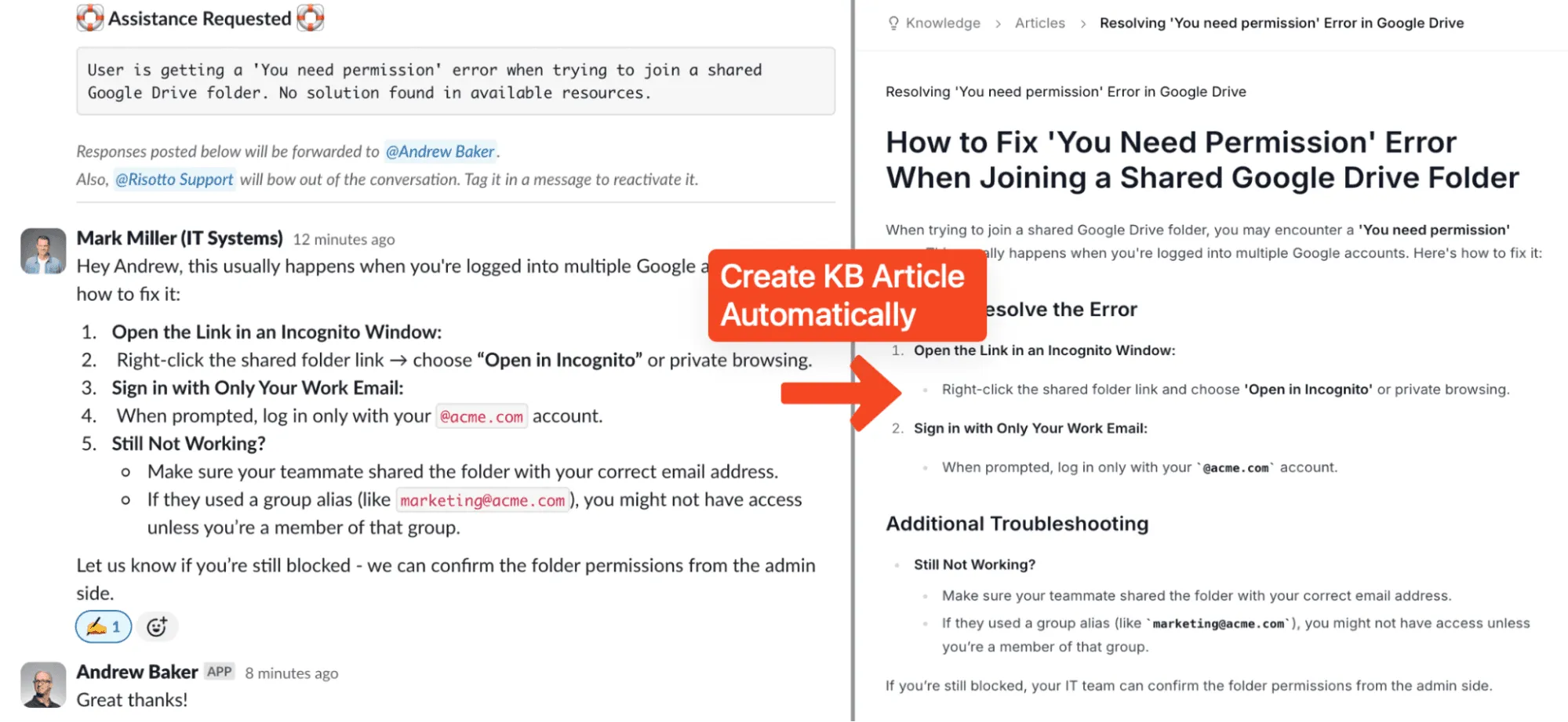
Escalation scenario: Risotto escalates to the right team member when issues can't be resolved automatically.
It knows camera issues are AV team problems, so it posts the ticket in the appropriate Slack channel and tags Amanda, who has experience with camera equipment (which Risotto can identify based on her past ticket history).
Amanda can see the complete conversation history — Andrew's original question and all of Risotto's troubleshooting steps. She immediately understands that standard solutions have been tried, and this requires hands-on assistance. She replies, "Hey Andrew, I'll be right there!"
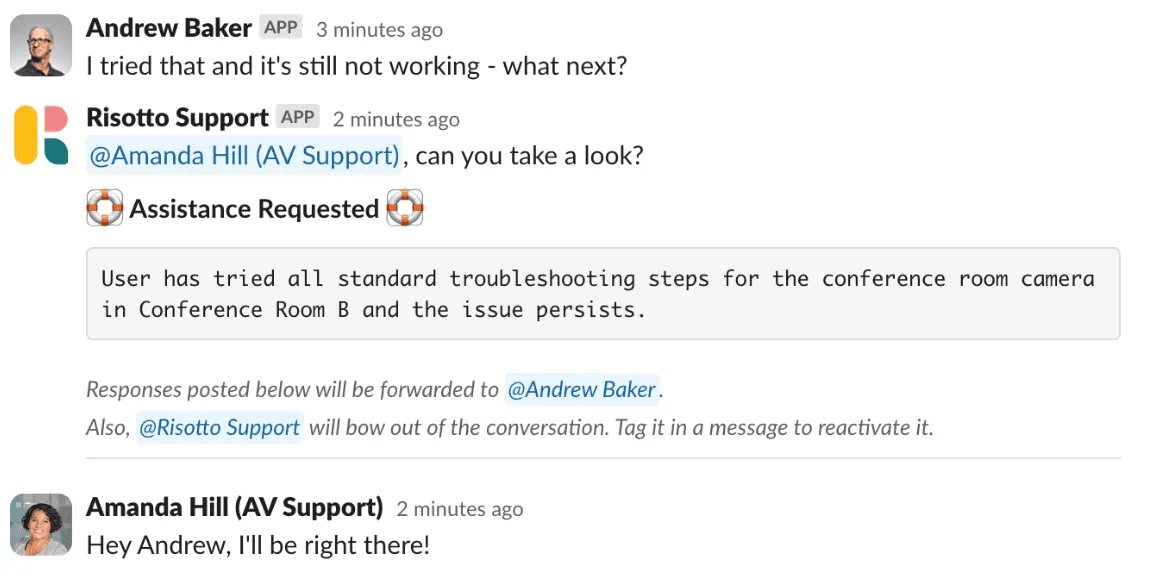
This context-aware handoff means Amanda doesn't waste time re-asking questions or repeating solutions, and Andrew gets faster resolution without having to explain the problem again.
Example #2: Adapting to Context Changes

Employee question:
“How can I get an employee badge?”
Risotto’s response:
“To obtain an employee badge, follow these steps:
- Requesting Your Badge: For new employees, you will get your badge during onboarding.
- Badge Pickup: Once your badge is ready, you will be notified by the Facilities team.
- Badge Setup: IT will activate your badge to ensure it is linked to your employee profile.”
A curveball is thrown into the equation:
The employee replies, "I actually just need a temporary one, I left mine at home."
Risotto intelligently adapts:
Risotto recognizes the context shift and responds: "If you forgot your badge at home, visit the reception desk to obtain a temporary day badge."
This mirrors how experienced IT agents actually work — adapting to new information rather than repeating scripted responses.
Example #3: Screenshot Recognition

Employee uploads a screenshot: "Can you help with this issue?" (No other context provided besides the attached image.)
Risotto analyzes the image: It identifies this as an AWS VPN connection issue.
Risotto responds: "We no longer use AWS VPN and have switched to Cloudflare. For instructions on signing into Cloudflare, see this how-to-guide.”
Bottom-line benefit: The ticket is automatically solved without requiring human intervention.
Example #4: Combining Multiple Knowledge Sources
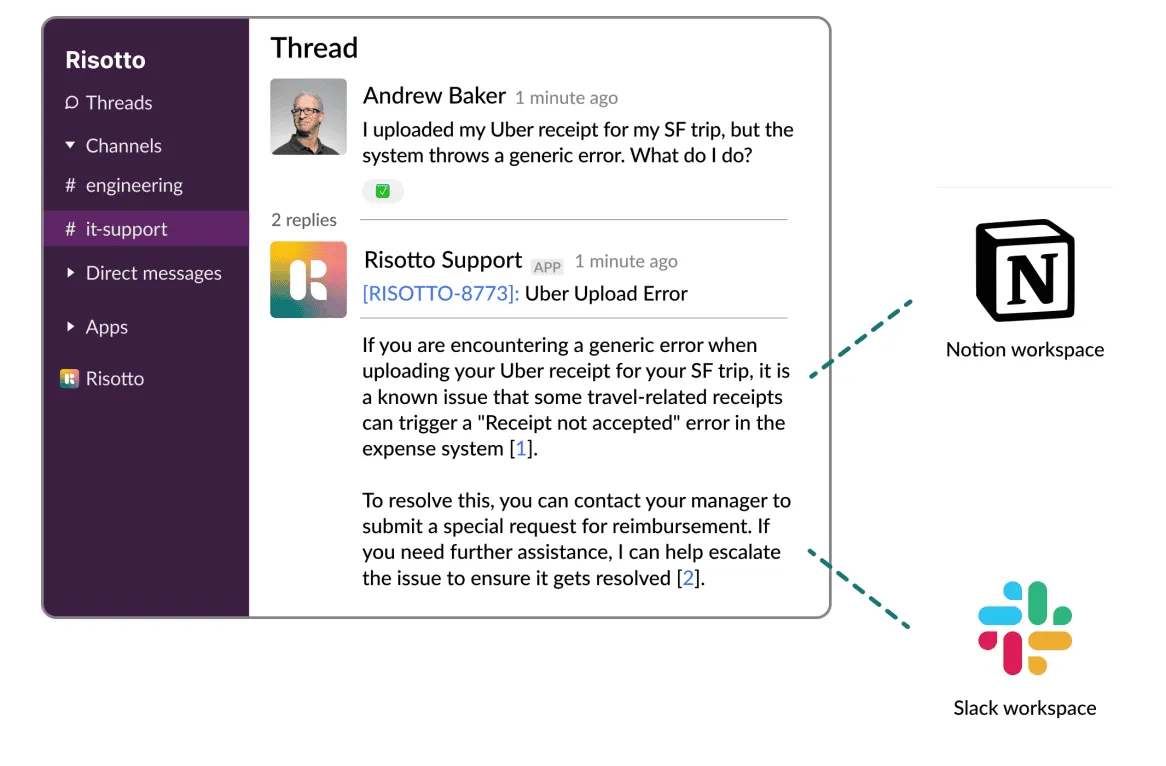
Risotto recognizes when knowledge base articles are incomplete or outdated, automatically supplementing answers with recent Slack conversations and ticket history.
For example, if someone asks about SOC2 compliance status and Risotto can't find any KB articles on the topic (or finds outdated ones), Risotto searches for recent Slack updates from the InfoSec team regarding SOC2 and uses that information to base its response. This ensures accurate, current information and fills the gaps when KB articles fall short.
Multi-Department Expansion
Risotto's adoption typically follows a natural progression:
- Phase 1: IT teams deploy Risotto alongside Jira (via bi-directional sync), automating 20–60% of tier-1 tickets and serving more employees without expanding headcount.
- Phase 2: Other departments see IT's results and want similar AI automation capabilities. Since they don't need Jira’s complexity, they adopt Risotto's built-in ticketing system instead.
As we explore in the Superhuman case study, beyond IT, Risotto also handles requests for compliance, finance, and HR/people operations. Colin noted, “The multi-department capabilities are awesome. Our engineering and RevOps teams now also want to use Risotto as they also get lots of the same questions over and over again”.
Book a Demo Call
We invite you to schedule a demo and experience Risotto in action.
Our customers are achieving measurable results:
- Hazel Health Case Study: Increased deflection rates from 3–5% to 20% after switching from Jira Assist & Atlassian Virtual Agent to Risotto.
- Fundrise Case Study: Automated nearly 60% of all IT support tasks.
- Superhuman Case Study: Automated nearly 20% of all IT support requests.
- Retool Case Study: Cut SLA for solving support issues from 2 days to under 1 day on average.
- Vidyard Case Study: Automated nearly 56% of IT requests.
2. Zendesk
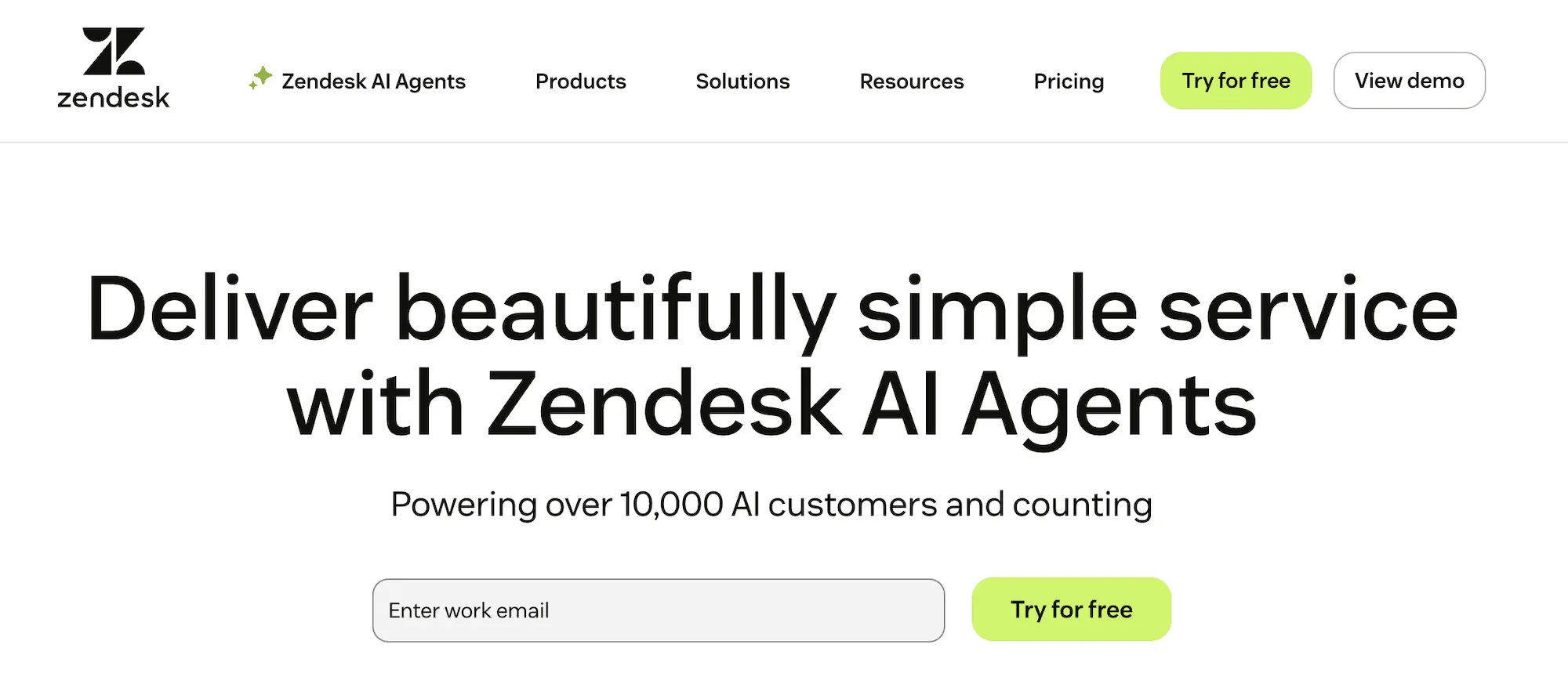
Zendesk launched in 2007 as a customer support platform and has gradually expanded into IT and internal support over the years.
If you already have a customer service team using Zendesk for external support and you're a smaller company (under 500 employees), their IT solution could work well for you. It may be more cost-effective and efficient to consolidate ticketing tools rather than adding another help desk platform.
However, Zendesk may not be the right fit for IT teams if your customer support team doesn't already use Zendesk, you have a larger company with well over 500 employees, and you need more powerful ITSM functionality.
Some of Zendesk’s key features and capabilities include:
- Incident Management
- Problem Management
- Service Request Fulfillment
- Change Management
- Knowledge Management
- SLA Management
- AI Agents
- Service Desk
- Performance Metrics
- AI and Automation
They offer a user-friendly interface that caters to various industries, including Retail, Financial Services, Education, Government, Manufacturing, Software, Healthcare, Telecommunications, and more.
3. Freshservice
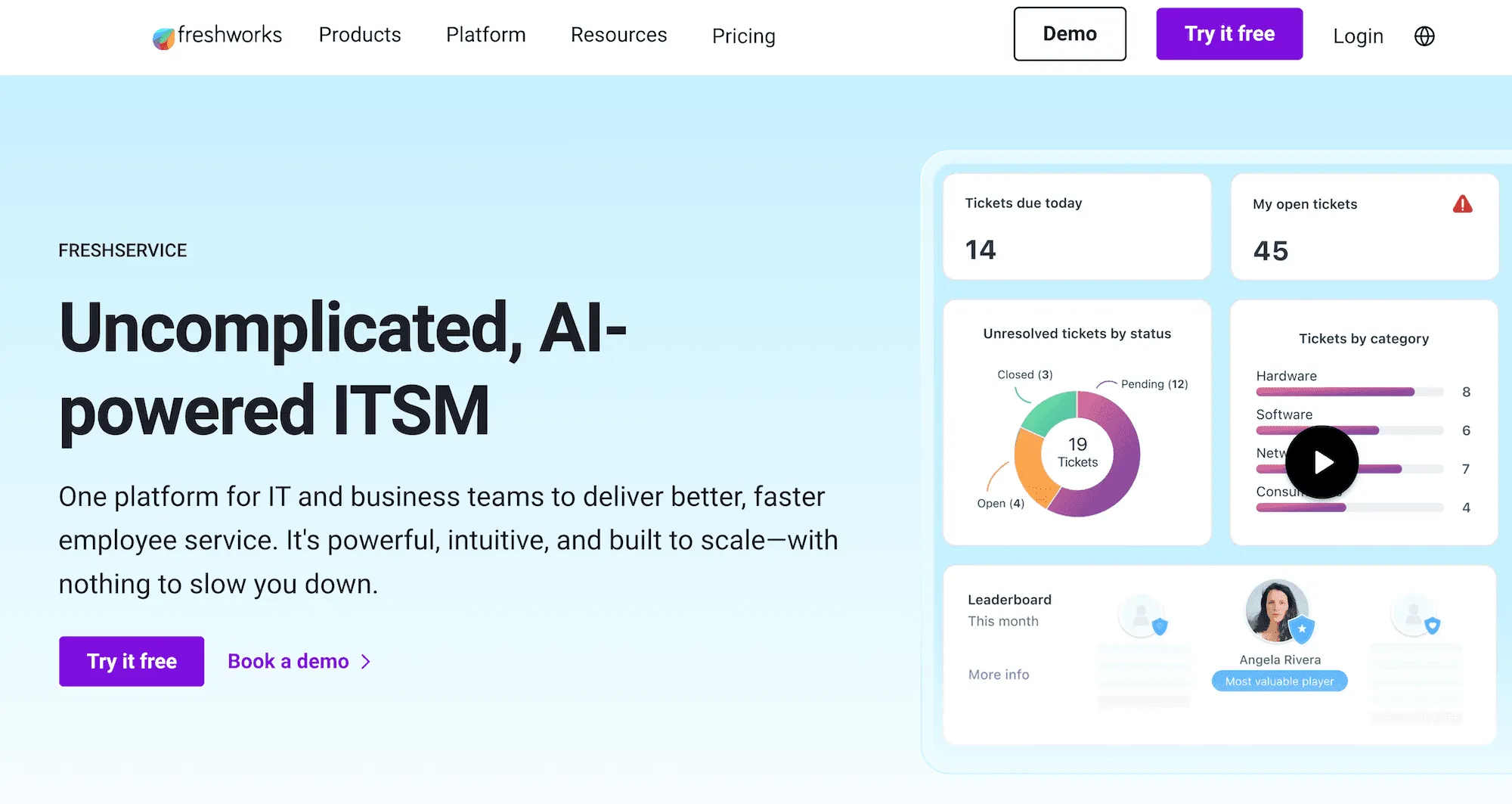
While Freshworks initially launched in 2010 for customer support, they took a different strategic path than competitors like Zendesk by creating Freshservice as a separate, dedicated ITSM product in 2014.
Compared to Zendesk, in our experience, Freshservice has more robust ITSM functionality.
Some of Freshservice’s key features and capabilities include:
- Incident Management
- Change Management
- Problem Management
- Omnichannel Support
- Service Catalog
- Knowledge Management
- SLA Management
- Asset Lifecycle Management
- Project Management
- Workflow Automation
- ITIL-Compliant Processes
- Intelligent Ticket Routing
- AI Agents
4. ServiceNow

If you're a multinational corporation with tens of thousands of employees and a substantial IT budget, then ServiceNow may be the right fit.
While it demands substantial investment in both time and resources to realize its full potential, ServiceNow is incredibly powerful and can be tailored to virtually any enterprise requirements.
Some of ServiceNow’s key features and capabilities include:
- Incident management
- Knowledge Management
- Change management
- Problem management
- Service Catalog
- Asset Management
- Request Management
- Service Level Management
- Self-Service Portal
- Customizable Templates
- Configuration Management Database (CMDB)
- Virtual AI Agents
- Now Assist for ITSM (Generative AI)
- AI Search
- DevOps Change Velocity
- DevOps Config
They offer great enterprise scalability, and you can browse their solutions by industry, including Automotive, Banking, Insurance, Life Sciences, National Government, Retail, Consumer Packaged Goods, Manufacturing, Technology Providers, Healthcare, Nonprofit, and Telecom.
5. PagerDuty
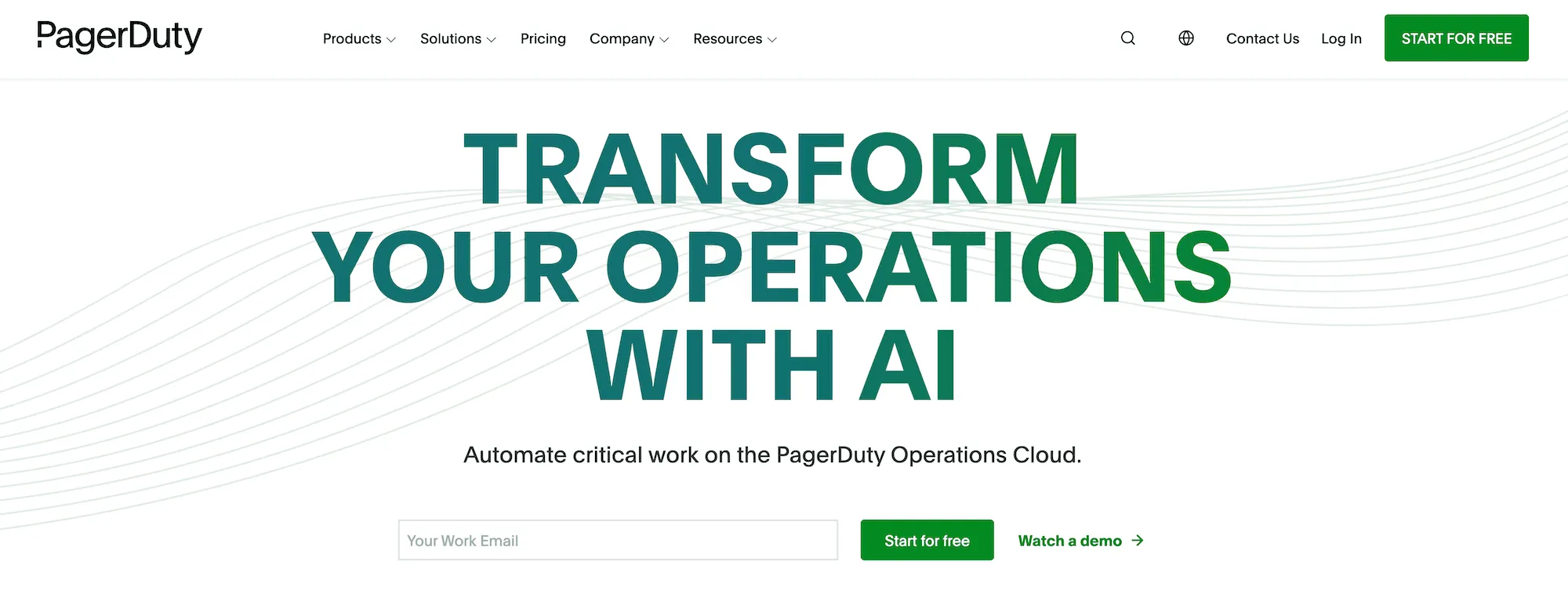
PagerDuty specializes in real-time incident management and response. According to its site, “nearly 70% of Fortune 500 companies rely on PagerDuty” for managing time-critical operations. Notably, many organizations use PagerDuty as an add-on to existing ITSM ticketing tools. They offer pricing plans that cater to all business types.
Some of PagerDuty's key features and products include:
- Incident Management
- Automation
- Status Pages
- Customer Service Ops
- AI Agents
- PagerDuty Advance (Generative AI)
- AIOps
Some of their key use cases include LLMOps, DataOps, FinOps, ComplianceOps, and CrisisOps.
Some of the key industries they serve include Financial Services, Healthcare, Non-Profit, Public Sector, Retail, and AI Infrastructure.
6. Ivanti

Ivanti provides enterprise service management across multiple departments, not just IT. With that said, they do offer an IT service management platform called Ivanti Neurons, which offers powerful ITSM functionality.
Some of Ivanti’s key features and capabilities include:
- Incident Management
- Problem Management
- Change Management
- Service Catalog
- Asset Management
- AI and Automation
- Knowledge Management
- Ticket Management
- CMDB
- Generative AI for ITSM
- Seamless integrations
Overall, it’s a great cloud-based platform for large enterprise companies looking to improve IT operations.
7. BMC

BMC’s flagship ITSM offering is BMC Helix ITSM (cutting-edge AI and machine learning capabilities), which represents the next generation of their renowned Remedy platform.
Some of their key features and capabilities include:
- AI Agents
- Knowledge Management
- Conversational Customer Assistance
- AI-Driven Incident Clustering
- Change Risk Analysis
- Integrated Discovery and AIOps
- Unified Service and Operations Management
Interested In Risotto?
Risotto is an AI-powered ITSM solution that can help you solve 20–60% of tier-1 tickets. We offer a great user experience and ease of use for both IT teams and end users, and integrate with Jira software via seamless bi-directional sync.
We invite you to schedule a demo call and see Risotto in action.
Back to blog

"Risotto had the most thorough onboarding experience I've ever been a part of. Alex was great - he met with us weekly and made it very easy to quickly get up and running."
Try Risotto for free for 30 days. Commit only when you see the value.

Want faster solutions and happier employees?
Risotto handles repetitive support requests across tools and teams, so IT gets back to solving real problems, not rerunning the same ones.
Get your free demo
.webp)
.svg)




